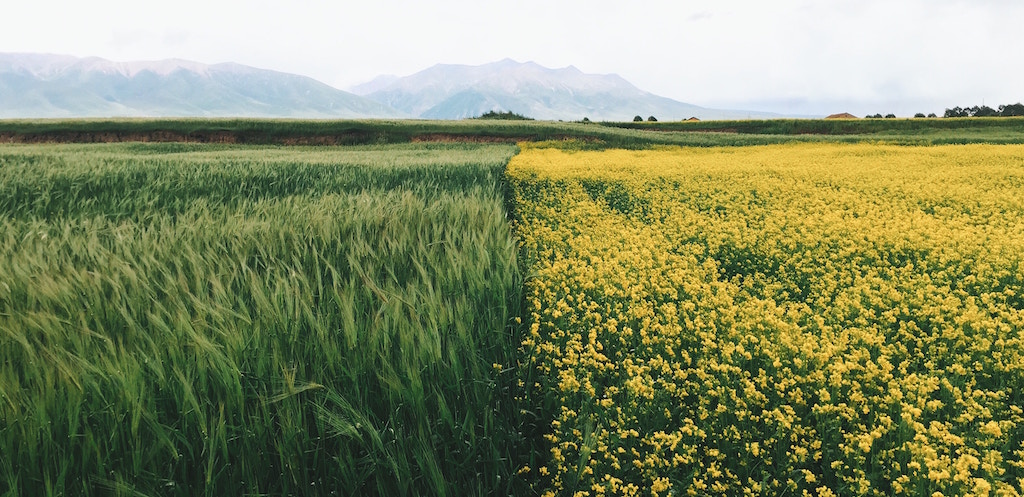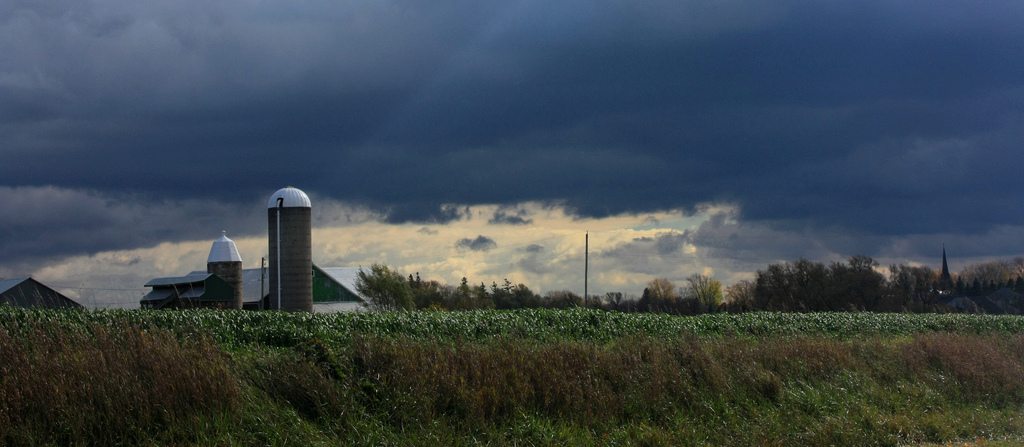
Hillary Bonhomme
The day is cold and windy, a sunny but bracing 32 degrees in New York City. But at the Union Square Greenmarket, one of more than 50 farmers’ markets in the city, and a stalwart in operation since 1976, a brisk business is afoot at the Regional Grains Project stand. While the winter tends to be quiet for many regional farmers who sell their products at the market, it’s high season for the stand, a collaborative effort between the Greenmarket and a number of farmers, millers, and distributors in the Northeast.
Piled high with freshly milled flours, whole grains, beans, and cooking oils, all sourced from the northeastern United States, the stand sees a steady early morning stream of visitors. Home bakers, interested eaters, and regulars all pop by to pick up bulk bags of rolled oats for the hot breakfasts that sustain them through winter’s last gasp. A baker connected to Greenmarket favorite She Wolf Bakery, stops by to pick up several bulk bags of rye flour—a stopgap measure meant to last until the company can get a full pallet of flour from the same mill.
While the initiative was built in part to serve bakeries operating in the Greenmarket—bakeries now required to use at least 15 percent local and regional grains in their products—it has grown to serve bakers and breadmakers who work outside the bounds of Union Square park, too.
What’s the saying—build it and they will come? When it comes to regional grain-sheds, maybe it’s more like build it and they will clone.
That’s what’s happened with the Regional Grains Project, which has been replicated across the country from California’s CA Grain Campaign, Colorado’s Noble Grain Alliance, and the Maine Grain Alliance, to informal networks cropping up in places like Austin, Texas; Ann Arbor, Michigan; New Orleans, Louisiana, and even Saskatoon, Saskatchewan in Canada. These efforts, along with increasing popular interest in whole-grain baking, fresh milling, and the advantages of sourdough baking, showcase how the local grains movement has matured. These are places where demand for healthy, flavorful food is being matched with economic viability and soil health for farmers and rural communities.
One of the clearest indicators that regional grain-sheds are starting to thrive is the rise of local bakeries. From Skowhegan, Maine to Spokane, Washington, cities large and small have seen a renaissance of whole-grain bakers using freshly milled flour. And though local grains and can be more expensive than commodity counterparts—it’s not uncommon to find a loaf of bread priced at $10 or more—their customers are apparently willing to pay for it. At least some Americans seem to accept that bread that costs more to produce, and is baked by skilled bakers who make sustainable livings, will also cost more to buy.
But, wait. This escalated pricing raises an important question about who gets to access these products, and in turn, reveals a critical inflection point in the regional grains revival. While we wait for capacity to be built, which will eventually decrease costs and raise the efficiencies of distribution for regional grains, who is the customer for $10-a-loaf, whole-grain bread?
Though local grains and can be more expensive than commodity counterparts—it’s not uncommon to find a loaf of bread priced at $10 or more—customers are apparently willing to pay for it
The fact is, there was a greater degree of economic equity at the time the farmers’ market movement took hold in the 1970s. American incomes have stagnated since then, with four decades of losses in real wages and two recessions in the past ten years—which may provide some clue as to why access to local food markets is, especially since 2012, much diminished. This reality coincides with research from the United States Department of Agriculture (USDA) affirming that, while there is still great demand for local food, much of the energy in farmers’ market and CSA growth, at least, has cooled off—even as institutional purchasing mores are shifting toward more local sourcing.
Specialty bakers and heirloom grains growers also face up against a specific economic issue: Government programs, including subsidies, skew the actual cost of goods. The average wholesale cost for commodity wheat flour in this country runs about 46 cents a pound; organic commodity wheat can be priced slightly higher, and regional and small grains production closer to $1 a pound, if not more for specialty cereals like spelt, einkorn, and emmer. Most of these growers also practice better-than-average soil care compared to commodity growers who, while coming around on the issue of soil health, have also relied on taxpayers to facilitate cleanup and pay for the environmental externalities of commodity grain production. While commodity flour at retail is cheaper than local or regional grain, its relative cheapness is misleading—the hidden costs of production can be found in our tax bills, if not always on the price tag in the store.
When it comes down to it, the issue of market expansion requires more than building capacity. Education and promotion will continue to be important, as will finding viable intersections between the grains movement and public health outreach groups, nutritionists, and food policy councils, who have all been helpful in gaining local foods leverage in school districts, prisons, and other public-sector agencies.
It will require the will of the whole community of growers, millers, bakers, and even eaters to generate and sustain good price points on foods made with local grains. Access is about many things beyond just putting more of a certain kind of food in front of people. Regional grain advocates could fold that reality into their existing efforts to build awareness around the regional grain-shed.
But before we lose ourselves entirely in building capacity for regional grains themselves, it is critical to take a step back and build capacity for small-scale entrepreneurs to access capital and eaters to purchase at the price points farmers, millers, and bakers require to survive.
Back at the Greenmarket, a group of school children comes to the stand, teacher in tow. “We’re buying rolled oats, to make oatmeal with apples and honey, all from the market—right everyone?” The students cry out enthusiastically. The connections they make with these foods today builds their connection with those foods later in life, nurturing eating habits, culinary skills, and an understanding of foodways in their orbit. It is part of the work of the regional grains movement, and local foods advocates in general, to make sure they will be able to afford it.
Disclosure: As a former market manager for GrowNYC’s Greenmarket Program, Stephen S. Wade helped manage the Regional Grains Project.











